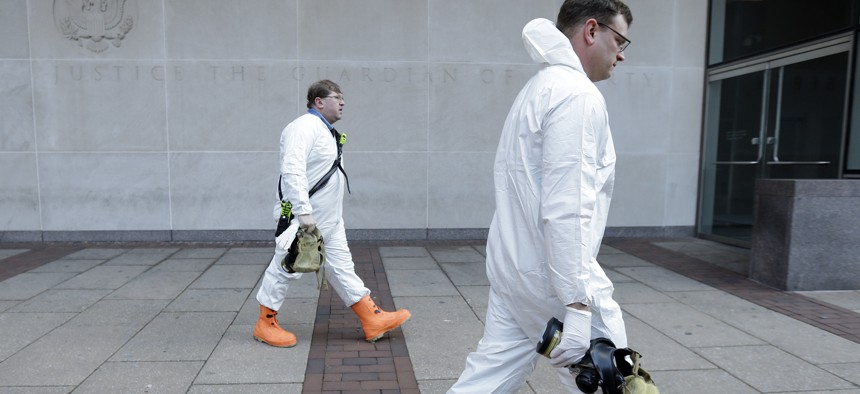
Firefighters in protective clothing prepare to enter the U.S. Courthouse in Philadelphia Wednesday, Feb. 20, 2013. AP / MATT ROURKE
Pentagon: We Don’t Actually Know How Much Anthrax We Mailed Ourselves
A week after the Defense Department admitted it mistakenly sent live anthrax to various labs, officials upped the number of recipients and said the investigation was still going on.
Today, the Pentagon again revised upward the number of Defense Department-affiliated sites to which it may have accidently sent live anthrax. The sites now number 51 in 17 states, plus the Pentagon itself, Osan Air Force Base in South Korea, and facilities in Australia and Canada.
That’s a big jump from last week. On Wednesday, DoD officials admitted that the military had sent anthrax to labs in 9 states. On Friday, it upped the total to 24 labs in 11 states.
It ain’t over. “We suspect this number may rise because of the the scope of the investigation,” Deputy Defense Secretary Bob Work told reporters during a briefing at the Pentagon today.
Pentagon officials also announced that 31 people are taking a post-exposure prophylaxis called ciprofloxacin, or cipro for short. Of those, 22 are in South Korea while the rest are in the United States.
“I would like to emphasize to everyone here that there are no suspected or confirmed cases of anthrax infection of any of the workers in any of the labs.” said Work. “The concentration in these samples are too low to infect the average, healthy individual.”
Testing is ongoing. The results of the ongoing investigation will be available here. Bottom line: the department does yet know the real scope of the problem.
“The Department ... directed the four laboratories that maintain the repository for these samples … to test every previously inactivated anthrax sample that we have to ensure that it is, in fact, killed. That is why the numbers may rise. We have a number of lots we need to inspect and verify… it takes ten days to do the tests and that’s why the number may grow,” he said. “We’ve been following these protocols for 10 years and this is the first time this has been brought to our attention.”
The Defense Department has issued a new directive to review all the protocols associated with irradiating anthrax. Conventional sterility testing, which is conducted after a lab irradiates live spores, did “not detect the presence of live anthrax,” Work said. That basically means that the methods that the Defense Department was using to make sure that the anthrax samples that they they were mailing were dead may have been innately—damningly—flawed. “We need to know why,” said Work. “This is not going to be a 9-to-5 endeavor. We are going after this as fast as we can.”
Four military labs possessed 400 lots of anthrax. Four of those lots have now turned up positive for live anthrax.




